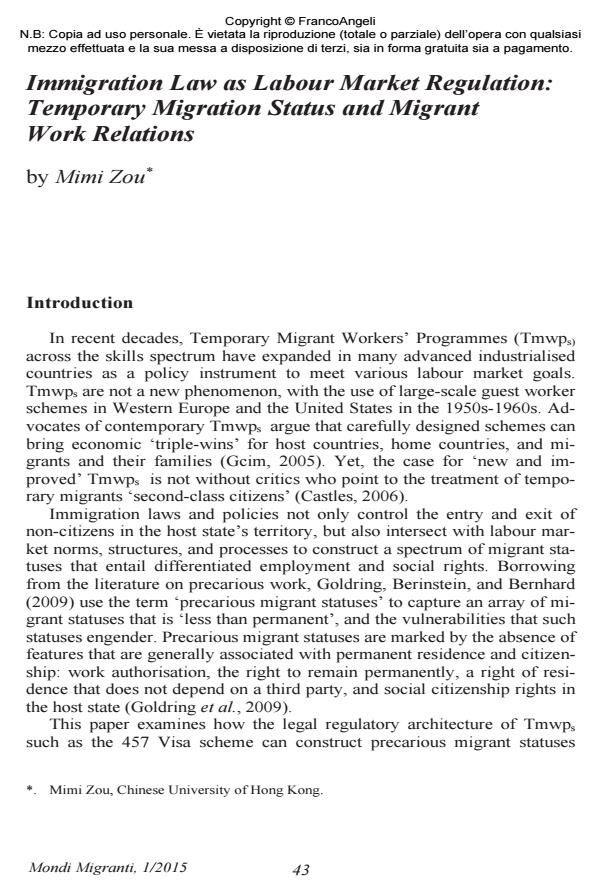Immigration Law as Labour Market Regulation: Temporary Migration Status and Migrant Work Relations
Titolo Rivista MONDI MIGRANTI
Autori/Curatori Mimi Zou
Anno di pubblicazione 2015 Fascicolo 2015/1
Lingua Inglese Numero pagine 22 P. 43-64 Dimensione file 75 KB
DOI 10.3280/MM2015-001003
Il DOI è il codice a barre della proprietà intellettuale: per saperne di più
clicca qui
Qui sotto puoi vedere in anteprima la prima pagina di questo articolo.
Se questo articolo ti interessa, lo puoi acquistare (e scaricare in formato pdf) seguendo le facili indicazioni per acquistare il download credit. Acquista Download Credits per scaricare questo Articolo in formato PDF

FrancoAngeli è membro della Publishers International Linking Association, Inc (PILA)associazione indipendente e non profit per facilitare (attraverso i servizi tecnologici implementati da CrossRef.org) l’accesso degli studiosi ai contenuti digitali nelle pubblicazioni professionali e scientifiche
This paper examines the way in which immigration law function as a form of labour market regulation, which directly structure and shape the employment relations of migrants in advanced industrialised countries. In particular, Temporary Migrant Workers Programmes (Tmwps) have rapidly expanded in recent years and have been actively promoted by national and global policy makers as a desirable labour migration instrument for host states, home states, and migrants themselves. Through analysing the regulatory design and operation of a contemporary Tmwp - Australia's Subclass 457 Visa scheme - this paper seeks to develop a conceptual framework to elucidate the legal production of ‘precarious migration status’ and its role in shaping certain vulnerabilities in migrant work relations. These vulnerabilities are coined 'hyper-dependence’ and ‘hyper-precarity’. Hyper-dependence refers to a migrant worker’s extreme dependence on and subordination to her sponsor/employer for the legal authorisation to work and reside in the host state. It is concerned with a high degree of labour unfreedom inherent in the ‘tie-in’ structure of Tmwps, where there are de jure and de facto restrictions on migrant workers to change employers, occupations, sectors, and workplaces. The notion of hyper-precarity refers to the tenuous nature of these migrants' job security, employment and social protections that arise from their precarious statuses under Tmwps.
Questo articolo esamina il modo in cui il diritto dell’immigrazione funziona come forma di regolamentazione del mercato del lavoro, che struttura e forma direttamente i rapporti di lavoro dei migranti nei paesi industrializzati avanzati. In particolare, i Programmi per i lavoratori migranti temporanei (Tmwps), negli ultimi anni, sono stati velocemente ampliati e attivamente promossi dai politici nazionali e globali come strumento di acquisizione di lavoro desiderabile per gli Stati ospitanti, gli Stati di origine e gli immigrati stessi. Attraverso l’analisi del disegno normativo e il funzionamento di un Tmwp contemporaneo - lo schema Visa sottoclasse 457 in Australia - questo documento mira a sviluppare un quadro concettuale per chiarire la produzione legale del concetto di 'stato di migrazione precaria' e il suo ruolo nel plasmare alcune vulnerabilità nei rapporti di lavoro migranti. Queste vulnerabilità sono chiamate iper-dipendenza e iper-precarietà. Hyper-dipendenza si riferisce alla situazione di estrema dipendenza del lavoratore migrante e la subordinazione al suo sponsor/ datore di lavoro per l'autorizzazione legale a lavorare e a risiedere nello Stato ospitante. Si occupa di un alto grado di manodopera non libera insita nella struttura 'tie-in' di Tmwps, dove c’è de jure e de facto una restrizione per i lavoratori migranti nel cambiare datore di lavoro, professioni, settori e posti di lavoro. Il concetto di iper-precarietà si riferisce alla natura tenue di sicurezza del lavoro di questi migranti, l'occupazione e la protezione sociale che nascono dal loro status precario sotto Tmwps.
Parole chiave:Legge sull'immigrazione; programmi lavoratori migranti temporanei (Tmwp); Sottoclasse schema 457 Visa Australia, iper-dipendenza e iper-precarietà.
- Patchy progress? Two decades of research on precariousness and precarious work in Australia Iain Campbell, John Burgess, in Labour & Industry: a journal of the social and economic relations of work /2018 pp.48
DOI: 10.1080/10301763.2018.1427424
Mimi Zou, Immigration Law as Labour Market Regulation: Temporary Migration Status and Migrant Work Relations in "MONDI MIGRANTI" 1/2015, pp 43-64, DOI: 10.3280/MM2015-001003